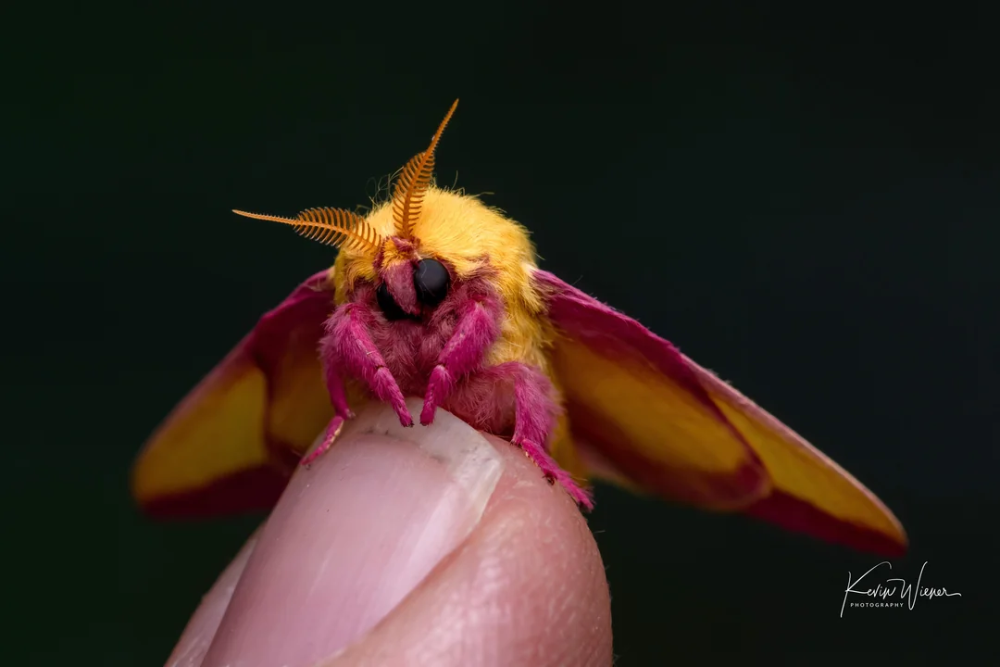In the enchanting world of insects, there exists a creature so delicate, so ethereal, that it seems to have emerged from the realms of fantasy rather than the natural world. The Rosy Maple Moth (Dryocampa rubicunda) stands as a testament to the exquisite diversity of life on our planet. With its pastel hues and delicate features, this moth captivates the hearts of all who encounter it, inspiring wonder and admiration for the intricate beauty of the natural world.
A Glimpse into Ephemeral Beauty
Native to North America, the Rosy Maple Moth is a member of the Saturniidae family, commonly known as giant silk moths. Despite its familial association with these giants, the Rosy Maple Moth is relatively small in comparison, typically boasting a wingspan of around 1.5 to 2 inches. However, what it lacks in size, it more than compensates for with its mesmerizing appearance.
Adorning itself in soft shades of pink, yellow, and cream, the Rosy Maple Moth exhibits a unique and unmistakable coloration that sets it apart from its counterparts in the insect world. Its wings, reminiscent of delicate petals, are adorned with bold splashes of pink and yellow, while its body features a soft, fuzzy texture that adds to its overall charm.

Life Cycle and Habitat
The life cycle of the Rosy Maple Moth is a testament to the wonders of nature’s intricacy. Like all moths, it undergoes a complete metamorphosis, starting its life as an egg laid by an adult female moth. These eggs are typically laid on the leaves of the maple tree, the primary host plant for the Rosy Maple Moth larvae.
Upon hatching, the larvae, or caterpillars, emerge and begin to feed voraciously on the leaves of the maple tree. As they grow, they undergo several molts, shedding their old exoskeletons to accommodate their increasing size. Once fully grown, the caterpillars spin silk cocoons in which they pupate, undergoing a transformative process within the safety of their silky enclosures.
After a period of several weeks, the adult moths emerge from their cocoons, ready to take flight and continue the cycle anew. As adults, their primary goal is to reproduce, perpetuating the cycle of life for future generations of Rosy Maple Moths.
Ecological Significance
While the Rosy Maple Moth may be celebrated for its aesthetic appeal, its ecological significance should not be overlooked. As larvae, these moths play a vital role in the ecosystem by consuming the leaves of the maple tree, thereby helping to regulate its growth and maintain overall forest health. Additionally, as adults, they serve as pollinators, transferring pollen from one plant to another as they feed on nectar, thus facilitating the reproduction of flowering plants.
Furthermore, the presence of the Rosy Maple Moth serves as an indicator of environmental health, as its presence is often indicative of thriving populations of maple trees, which require specific environmental conditions to flourish. By monitoring populations of Rosy Maple Moths, scientists can gain valuable insights into the health of forest ecosystems and the impact of environmental changes on native species.
Cultural and Symbolic Significance
Beyond its ecological importance, this animal holds cultural and symbolic significance for many people. Revered for its delicate beauty and ephemeral nature, this moth has inspired artists, poets, and storytellers for generations.
In indigenous cultures, the Rosy Maple Moth may hold symbolic significance, representing concepts such as transformation, rebirth, and the interconnectedness of all living things. Its presence in folklore and mythology serves as a reminder of the profound connection between humanity and the natural world, urging us to respect and cherish the fragile ecosystems that sustain us.
Conservation Efforts
Despite its undeniable allure, the Rosy Maple Moth, like many other species of insects, faces threats to its survival. Habitat loss, pesticide use, and climate change all pose significant challenges to the continued existence of this delicate creature.
To ensure the long-term survival of the Rosy Maple Moth and other native species, conservation efforts are essential. These efforts may include habitat restoration projects, public awareness campaigns, and the implementation of sustainable land management practices aimed at preserving the diverse ecosystems that these moths call home.
By working together to protect the habitats and species that enrich our world, we can ensure that future generations will continue to marvel at the exquisite beauty of creatures like the Rosy Maple Moth for years to come.
Conclusion
In a world filled with wonders both great and small, few creatures captivate the imagination quite like the Rosy Maple Moth. With its delicate beauty, intricate life cycle, and ecological significance, this enchanting insect serves as a reminder of the extraordinary diversity of life on our planet.
As we strive to protect and preserve the natural world, let us not forget the humble yet magnificent creatures that inhabit it. May the Rosy Maple Moth continue to flutter through our forests, a symbol of resilience, beauty, and the interconnectedness of all living things.









